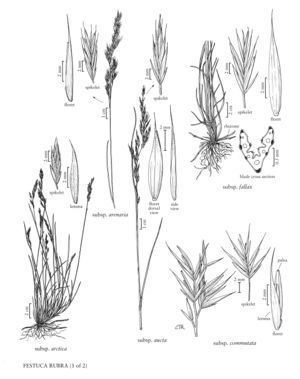Difference between revisions of "Festuca rubra subsp. fallax"
FNA>Volume Importer |
imported>Volume Importer |
||
| (8 intermediate revisions by 2 users not shown) | |||
| Line 7: | Line 7: | ||
|synonyms={{Treatment/ID/Synonym | |synonyms={{Treatment/ID/Synonym | ||
|name=Festuca rubra var. multiflora | |name=Festuca rubra var. multiflora | ||
| − | |authority= | + | |authority= |
| − | }}{{Treatment/ID/Synonym | + | |rank=variety |
| + | }} {{Treatment/ID/Synonym | ||
|name=Festuca rubra subsp. multiflora | |name=Festuca rubra subsp. multiflora | ||
| − | |authority= | + | |authority= |
| − | }}{{Treatment/ID/Synonym | + | |rank=subspecies |
| + | }} {{Treatment/ID/Synonym | ||
|name=Festuca rubra var. fraterculae | |name=Festuca rubra var. fraterculae | ||
| − | |authority= | + | |authority= |
| − | }}{{Treatment/ID/Synonym | + | |rank=variety |
| + | }} {{Treatment/ID/Synonym | ||
|name=Festuca heteromalla | |name=Festuca heteromalla | ||
| − | |authority= | + | |authority= |
| − | }}{{Treatment/ID/Synonym | + | |rank=species |
| + | }} {{Treatment/ID/Synonym | ||
|name=Festuca diffusa | |name=Festuca diffusa | ||
| − | |authority= | + | |authority= |
| + | |rank=species | ||
}} | }} | ||
|hierarchy=Poaceae;Poaceae subfam. Pooideae;Poaceae tribe Poeae;Festuca;Festuca subg. Festuca;Festuca sect. Festuca;Festuca rubra;Festuca rubra subsp. fallax | |hierarchy=Poaceae;Poaceae subfam. Pooideae;Poaceae tribe Poeae;Festuca;Festuca subg. Festuca;Festuca sect. Festuca;Festuca rubra;Festuca rubra subsp. fallax | ||
| Line 31: | Line 36: | ||
-->{{Treatment/Body | -->{{Treatment/Body | ||
| − | |discussion=<p>Festuca rubra subsp. fallax is a robust taxon that grows in damp, often disturbed places. It is native to northern and central Europe, but has been introduced widely in the Flora region, occurring from British Columbia to eastern Quebec and south to California. It is now common in some areas, occasional in others.</p><!-- | + | |discussion=<p><i>Festuca rubra </i>subsp.<i> fallax</i> is a robust taxon that grows in damp, often disturbed places. It is native to northern and central Europe, but has been introduced widely in the Flora region, occurring from British Columbia to eastern Quebec and south to California. It is now common in some areas, occasional in others.</p><!-- |
| − | --><p>Festuca rubra var. fraterculae Rasm., an unusual form described from the nesting colonies of Atlantic puffins (Fratercula arctica) on the Faeroe Islands and reported as introduced to southern Greenland, is included here in F. rubra subsp. fallax. Its luxuriant growth (flat leaves 4-7 mm wide, long stolons, and rhizomes) appears to be a phenotypic response to the soil conditions created by the puffins.</p> | + | --><p><i>Festuca rubra</i> var. fraterculae Rasm., an unusual form described from the nesting colonies of Atlantic puffins (Fratercula arctica) on the Faeroe Islands and reported as introduced to southern Greenland, is included here in <i>F. rubra </i>subsp.<i> fallax</i>. Its luxuriant growth (flat leaves 4-7 mm wide, long stolons, and rhizomes) appears to be a phenotypic response to the soil conditions created by the puffins.</p> |
|tables= | |tables= | ||
|references= | |references= | ||
| Line 41: | Line 46: | ||
-->{{#Taxon: | -->{{#Taxon: | ||
name=Festuca rubra subsp. fallax | name=Festuca rubra subsp. fallax | ||
| − | |||
|authority=(Thuill.) Nyman | |authority=(Thuill.) Nyman | ||
|rank=subspecies | |rank=subspecies | ||
| Line 48: | Line 52: | ||
|basionyms= | |basionyms= | ||
|family=Poaceae | |family=Poaceae | ||
| + | |illustrator=Cindy Roché | ||
| + | |illustration copyright=Utah State University | ||
|reference=None | |reference=None | ||
|publication title= | |publication title= | ||
|publication year= | |publication year= | ||
|special status= | |special status= | ||
| − | |source xml=https:// | + | |source xml=https://bitbucket.org/aafc-mbb/fna-data-curation/src/200273ad09963decb8fc72550212de541d86569d/coarse_grained_fna_xml/V24/V24_587.xml |
|subfamily=Poaceae subfam. Pooideae | |subfamily=Poaceae subfam. Pooideae | ||
|tribe=Poaceae tribe Poeae | |tribe=Poaceae tribe Poeae | ||
Latest revision as of 16:24, 11 May 2021
Plants cespitose, strongly rhizomatous, stoloniferous, sometimes with solitary culms. Culms 50-90(130) cm. Sheaths of innovations red-brown at the base, scarious, pubescent on the upper parts, shredding into fibers; blades usually flat and 2-7 mm wide, or loosely conduplicate and 0.8-2.5 mm in diameter; abaxial sclerenchyma in 5-9 broad strands; adaxial sclerenchyma always present. Inflorescences 9-15 cm, open, lax or erect. Spikelets 8-14(17) mm, with (4)6-10 florets. Glumes ovate-lanceolate to lanceolate, acute to acuminate; lower glumes 3.5-4.5(7) mm; upper glumes 5-6.5(8.5) mm; lemmas 5-7.5(9.5) mm, green or glaucous, often red-violet along the margins, glabrous, smooth, awned, awns 0.8-3.2 mm; anthers 3.5-4.5 mm. 2n = 42, 56, 70.
Discussion
Festuca rubra subsp. fallax is a robust taxon that grows in damp, often disturbed places. It is native to northern and central Europe, but has been introduced widely in the Flora region, occurring from British Columbia to eastern Quebec and south to California. It is now common in some areas, occasional in others.
Festuca rubra var. fraterculae Rasm., an unusual form described from the nesting colonies of Atlantic puffins (Fratercula arctica) on the Faeroe Islands and reported as introduced to southern Greenland, is included here in F. rubra subsp. fallax. Its luxuriant growth (flat leaves 4-7 mm wide, long stolons, and rhizomes) appears to be a phenotypic response to the soil conditions created by the puffins.
Selected References
None.
